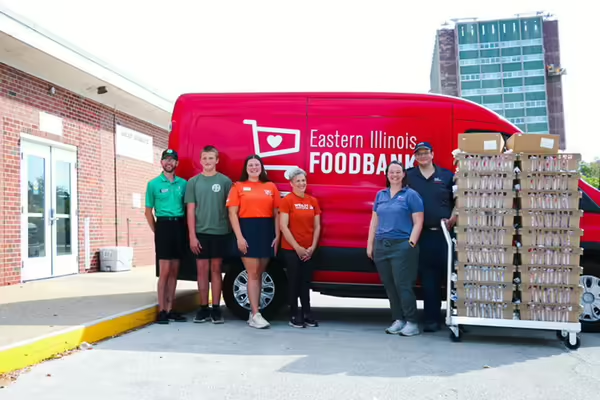
URBANA, Ill. — This year, Champaign County 4-H’er Austin Ater celebrated his 14th birthday in an extraordinary way — by giving back. The 2025 Illinois State Fair junior grand champion poultry exhibitor donated his record-setting winning pen of chickens to help fight hunger in the community.
Now in its second year, this Sale of Champions donation program reflects a growing partnership between the Illinois Department of Agriculture and the College of Agricultural, Consumer and Environmental Sciences at the University of Illinois Urbana-Champaign whereby meat from champion animals is processed by students and staff in the Meat Science Laboratory and donated to food banks across Illinois.
This year’s donation totaled more than 1,100 pounds of protein. Alongside Ater’s contribution, the shipment included beef exhibited by Kadie Hummel of Kankakee County, pork exhibited by Emma Rhoads of DeKalb County, lamb exhibited by Bryce Clayton of Scott County, and goat exhibited by Maddox Horner of Jasper County.
The meat was packaged into family-friendly portions and distributed locally through the Wesley Food Pantry, which serves the U. of I. campus community and surrounding neighborhoods. Wesley works in partnership with the Eastern Illinois Foodbank, the regional hub that supplies food to pantries across 21 counties, and with Feeding Illinois, the statewide network that connects these donations to families most in need.
Read the full article from College of ACES.
University of Illinois Extension develops educational programs, extends knowledge, and builds partnerships to support people, communities, and their environments as part of the state's land-grant institution. Extension serves as the leading public outreach effort for University of Illinois Urbana-Champaign and the College of Agricultural, Consumer and Environmental Sciences in all 102 Illinois counties through a network of 27 multi-county units and over 700 staff statewide. Extension’s mission is responsive to eight strategic priorities — community, economy, environment, food and agriculture, health, partnerships, technology and discovery, and workforce excellence — that are served through six program areas — 4-H youth development, agriculture and agribusiness, community and economic development, family and consumer science, integrated health disparities, and natural resources, environment, and energy.